PinotFile: 7.4 October 13, 2008
|
New Zealand: Finicky Pinot Noir Thriving in Middle Earth
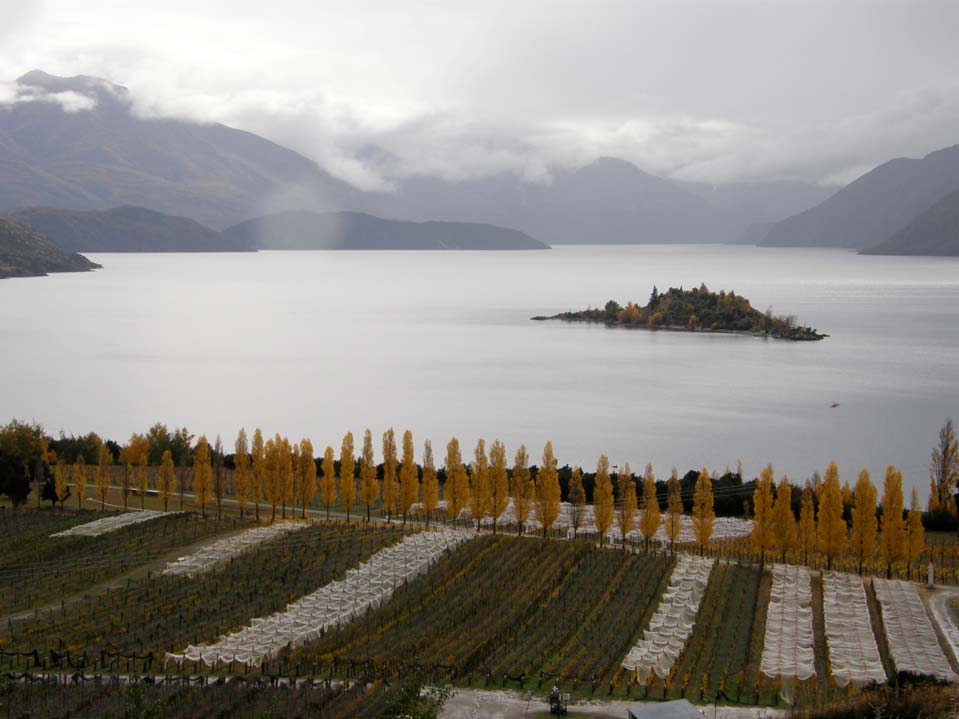 Sauvignon Blanc first fueled the worldwide interest in New Zealand wines, but it is Pinot Noir that is attracting the most attention now. New Zealand is only about the size of Oregon but between 2000 and 2007, Pinot Noir acreage increased 400% and planted acreage of Pinot Noir in 2007 in New Zealand (11,103 acres) has now surpassed Oregon (9,858 acres). The figures for Central Otago have been even more eye-popping with vineyard plantings increasing 800% from 500 acres in 1997 to more than 4,000 acres today, most of it Pinot Noir. Pinot Noir has recently overtaken Chardonnay as the second most planted variety behind Sauvignon Blanc and now accounts for 18% of New Zealand’s wine output (Sauvignon Blanc leads at 42%). Pinot Noir’s relative, Pinot Gris, has only been in New Zealand about 10 years, but has enjoyed a noticeable increase in popularity as well. Plantings have doubled since 2005 and the total planted acreage now surpasses that of Riesling. The number of Pinot Gris labels has increased 65% since 2005. Rosés are also fashionable in New Zealand, with nearly 100 different offerings, many crafted with Pinot Noir grapes. Sparkling wine production has decreased as vineyards become committed to still Pinot Noir wines. There were 543 members of the New Zealand Winegrowers association in 2007 and varying estimates put the total number of wineries at about 600 currently, up from 262 in 1997. In just ten years, the number of wineries in Central Otago has zoomed from 14 to 89. According to a recent report released by Drinks International, New Zealand experienced a record-breaking 16% rise in wine exports in 2007-2008, amounting to NZ $766 million. Exports are the lifeline of the New Zealand wine industry. The country produces 15-16 million cases of wine per year, exporting about 10 million cases. The population of 4 million people has an estimated 720,000 wine drinkers and only 35,000 hard-core premium wine drinkers. The numbers clearly reveal that New Zealand must look outside the country for its wine market. The United States will become the number one export market for New Zealand wines within a few years, surpassing the UK and Australia. Decanter (8/21/08) reported that export sales are projected to increase to NZ $1 billion by 2010. AC Nielsen estimated in 2007 that annual US sales of New Zealand wine was growing by more than 45%, much of this fueled by America’s thirst for Pinot Noir. The first vines in New Zealand were planted in 1819. A few years later, James Busby, a British immigrant brought cuttings from France and Spain to New Zealand. According to a recent report in Wine Country Cuisine NZ, he possibly brought Chardonnay from Clos de Vougeot Vineyard and probably Pinot Noir as well. By the early 1900s, Pinot Meunier was New Zealand’s main variety, accounting for two-thirds of the country’s plantings. There are reports of Pinot Noir cuttings being imported into New Zealand in about 1962, but the modern era of Pinot Noir viticulture began in the mid 1970s. Rolfe and Lois Mills of Rippon Vineyard on the banks of Lake Wanaka in the South Island (see photo on page 1) planted experimental Vitus vinifera in 1975 despite the consensus of the time that wine grapes could not be grown successfully this far south (at the time this was the most Southern vineyard in the world). After years of experiments, the couple planted Rippon’s vineyard in 1982, making it the first commercial block of vines in Central Otago since Gold Rush days. Other New Zealand wine pioneers included Tim and Judy Finn (Neudorf Vineyards in Nelson, South Island, planted in 1978), Neil McCallum (Dry River in Martinborough, North Island, planted in 1979), Clive Paton (Ati Rangi in Martinborough, North Island, planted in 1980), and Alan Brady (Gibbston Valley, Central Otago, South Island, planted in 1981). Geographically, New Zealand has both a North Island and South Island as shown on the New Zealand Winegrowers map on the next page. Wine grapes are grown throughout both Islands (growing latitudes are 36-45 degrees) except on the cold west coast and pocketed frigid areas. All the major grape growing regions have a maritime climate except Central Otago which is the only inland viticulture area blessed with a continental weather pattern. There are ten wine regions, only half of which have major plantings of Pinot Noir. The Wairarapa on the southeastern tip of the North Island and its multiple subregions including well-known Martinborough, is suitably cool for Pinot Noir. 40% of the planted acreage in Wairarapa is Pinot Noir. Nelson is located in the north-central part of the South Island and 25% of the vineyards are planted to Pinot Noir. Marlborough, in the Northeast corner of the South Island, has the largest and most recognizable wineries (Cloudy Bay, for example) and the largest plantings of Pinot Noir. Sauvignon Blanc is the King here, accounting for over 50% of production from this region. There are many inexpensive Pinot Noirs being produced in Marlborough. Canterbury lies along the South coast of the South Island from just south of Marlborough to south west of Christchurch. Waipara is a subregion in the northern part of Canterbury known for Pinot Noir. Central Otago is the most southerly wine region in the South Island. This is Lords of the Rings country known for its spectacular scenery. 60% of the vineyards are planted to Pinot Noir. The names of the wine regions reflect both English and the native Maori languages. The Polynesian navigator, Kupe, is historically reputed to be the first man to sight New Zealand in approximately 95 AD. He returned home after his discovery with news of his findings and in about 1350 AD, seven migratory canoes sailed from Hawaii to New Zealand. The native Maoris found an abundance of natural resources and flourished here. Surprisingly, 85% of New Zealand wineries are foreign-owned. Amisfield, in Central Otago, is owned by San Franciscan Tom Torsher, former CEO of Levi Strauss & Company. Grant Taylor, the owner and winemaker of Valli Vineyards and winemaker for Gibbston Valley Wines in Central Otago, hails from the United States where he helped establish Pine Ridge in the Napa Valley and Archery Summit in Oregon. Patrick Stow, another Napan, crafts Pinot Noirs at his Rimu Grove Winery in Nelson. British wine lover Nigel Greening bought Felton Road in 2000. The list goes on and on. Many notable American Pinot Noir winemakers work in New Zealand. Because New Zealand is located in the southern hemisphere, the growing season begins when North America’s season ends. Ted Lemon of Littorai and Guy Davis of Davis Family Wines are two names that travel yearly to New Zealand to consult and manage ongoing projects.
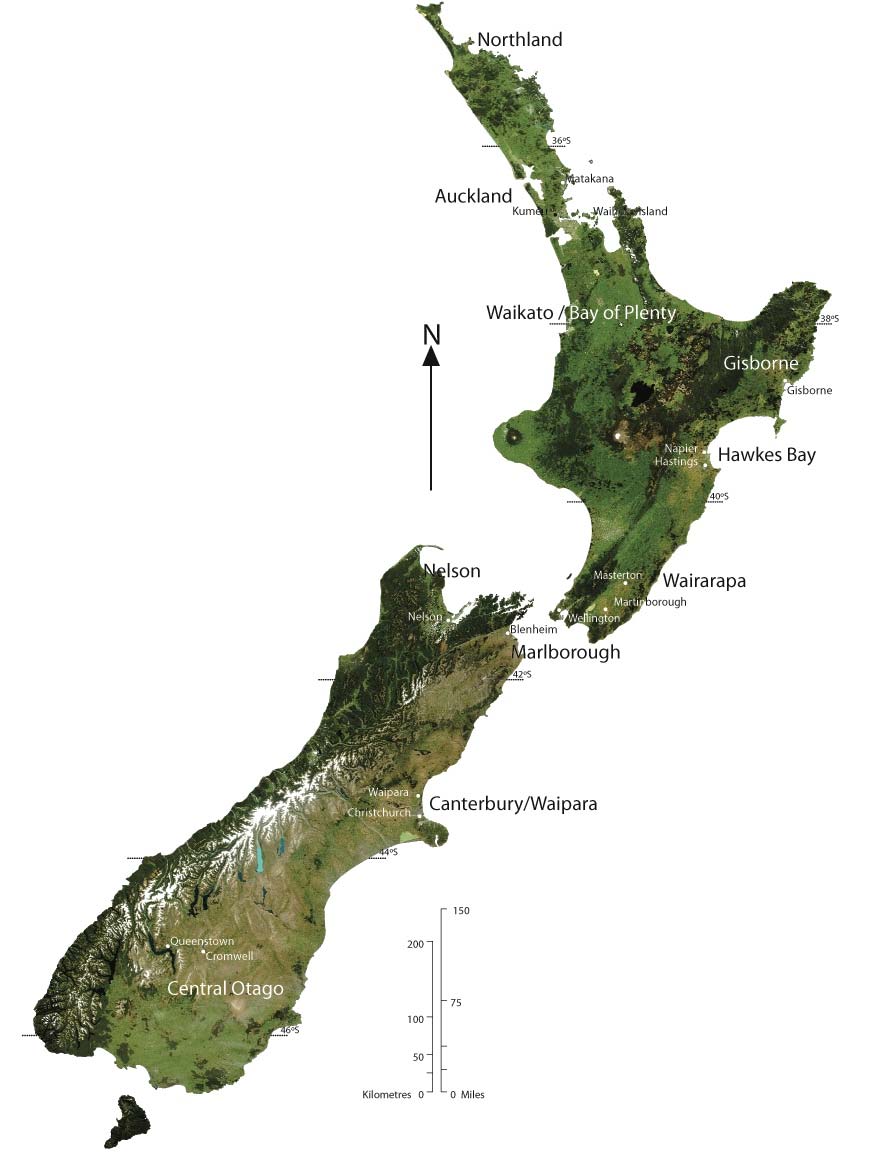 In the 1980s, Pinot Noir vines in New Zealand were primarily Pommard 5 and AM10/5 and AM2/10. Dijon clones were released by the New Zealand government in the 1990s and subsequently have been widely planted. There are suitcase clones in the ground as well. Phylloxera has surfaced in New Zealand but is not a significant problem yet. Spread is very slow and there is constant replanting and new planting of Pinot Noir vines. New Zealand vineyards have long been farmed organically and sustainably. The viticulture scheme here has always encouraged non-irrigated vines and the avoidance of insecticides. A code of sustainable practices, Sustainable Winegrowing New Zealand, was developed in 2002. Soils are primarily alluvial throughout the country, with some pockets of limestone. The New Zealanders pioneered the use of screw cap closures and since 2001 practically every winery uses them exclusively. Some of the wines shipped to the United States still are sealed with cork to avoid the cheap image that screw capped wines still have among wine enthusiasts here. Recently there has been considerable experimentation with Diam agglomerate cork and now about a third of wineries are using it on at least some bottlings. The style of New Zealand Pinot Noir is still evolving for the wine industry is still in its infancy and the vines are still relatively young. Attempts to define a distinctive style are challenging for there are vast differences in microclimates, viticulture and winemaking throughout the two islands. Vintage differences play a significant role in New Zealand as well. Like in California, there are stylistic extremes varying from elegant, restrained and classic Pinot Noirs, to more heavily extracted and generously oaked fruit bombs. Some wine critics characterize them as more Burgundian, others claim they reflect New World flashiness. Bennett Traub, writing in gangofpour.com, claims the wines fall in the middle: “They fit stylistically between the riper, more opulent style of Pinot Noir of top wines from Sonoma, Mendocino and Oregon, and classic, terroir-focused wines from Burgundy.” Generally the Pinot Noirs are fruit-driven with good color and a strong acid backbone. Criticism has centered most often on the lack of mid-palate material (thought to be secondary to young vines), the absence of complexity, the frequent abrupt finishes, and in some cases too much alcohol, extract or oak. Age ability seems to parallel typical California Pinot Noirs, with most wines very approachable upon release and peaking at three to five years. My impression, and this has been confirmed by research performed in New Zealand, is that there is a distinct difference between the heralded Pinot Noirs from Martinborough and Central Otago, arguably the best two regions for Pinot Noir in New Zealand. Henry Hariyono writes, “The style of Pinot Noir made in Central Otago is much in demand among younger wine drinkers in the United States today. With their rich, dark fruit aromas and flavors, intriguing floral and mineral nuances, and ripe, harmonious acidity - not to mention their often considerable heft (typically 14% alcohol) - they pose a threat to the more established Pinot Noirs of Martinborough, which while often more complex, earthy and Burgundian, can come off as drier and leaner in comparison with the fruit bombs from Central Otago.” Former sommelier Andy Tan prefers Martinborough Pinot Noir. He writes, “Martinborough is clearly my cup of tea. Always distinctly possessing more dark cherrysoaked liquor, more earthiness and structure. Central Otago wines, on the other hand, often lack complexity and are monotonously similar from one winery to another.” Last April, in the waning days of harvest, I spent two weeks in New Zealand as part of my lengthy trip down under which also included Australia’s Mornington Peninsula (a subsequent report will be forthcoming). I spent time in both Martinborough and Central Otago and my tasting mirrored the comments above. The Pinot Noirs from Martinborough are powerful and structured wines with sturdy tannins, earthiness, sometimes a subtle gaminess, minerality, and age ability. The Pinot Noirs from Central Otago, in contrast, displayed more vibrant fruit and flamboyance with some of the best wines offering delicacy and subtlety. The problem in Central Otago is that the wines are inconsistent with only a handful of stellar producers. One of my readers, Sonal Maharaj, sent me the results of recent research he participated in at the University of Auckland. During the 2007 vintage, small lots of Pinot Noir were made from grapes harvested from Central Otago, Marlborough and Martinborough. From each region, three vineyards of 10/5 clonal material, own rooted and 10 to 15 years of age, were selected. The grapes were harvested at 24 degrees Brix. Minimalist and standardized research-scale winemaking techniques were used. The wines were analyzed for total acidity, alcohol content, color density, tannin levels and levels of monomeric polyphenols such as resveratrol. The results showed good consistency between triplicates which supported confidence that the minimal intervention winemaking procedures had represented the grapes accurately. The results showed that the wines from Martinborough had more color and tannin and lower total acidity than those from Marlborough and Central Otago. These findings would tend to confirm the tasting impressions of myself and others described above. The results (yet unpublished) are summarized in the graphs below.
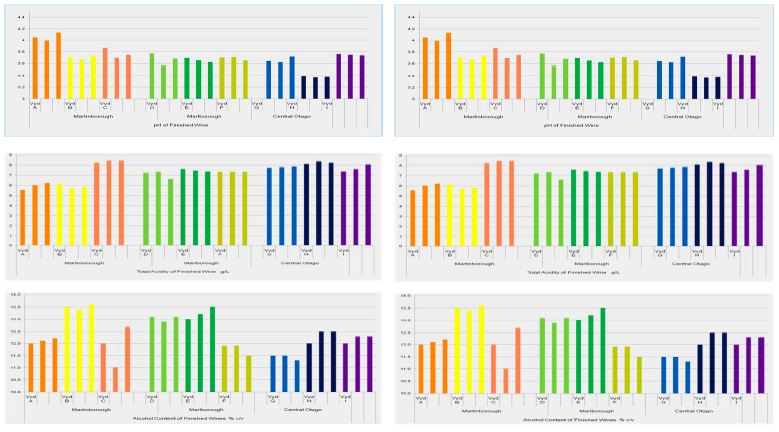 In the following pages, I will highlight two special wineries from Martinborough (Dry River and Escarpment) and Central Otago (Felton Road and Rippon). In addition, I have presented extensive tasting notes on Pinot Noirs from primarily Martinborough and Central Otago that I sampled upon returning home from my travels. These were mainly newly released Pinot Noirs that are in the retail marketplace in the United States. (For reviews of older vintages, consult PinotFile archives, Volume 5, issue 32.) Unfortunately, a number of the best wines from New Zealand cannot be found in America. Smaller wineries find it difficult to establish distribution in enough areas here to justify the expenses of exportation. Many of the boutique producers sell their entire production in New Zealand or countries where their demand is established. I have listed below several retail sources which regularly stock a decent selection of Pinot Noirs from New Zealand. You can also contact the distributors included in the reviews to locate a source. Private shipping of wine from New Zealand is prohibitively expensive.
The Jug Shop, San Francisco, California: www.jugshop.com Southern Hemisphere Wine Cellar, Huntington Beach, California: www.southernwines.com Wine Exchange, Orange, California: www.winex.com Hi Time Wine Cellars, Costa Mesa, California: www.hitimewine.com Piccadilly Beverage Shops, Champaign, Illinois: www.pbspicks.com Wine search engines: www.wineaccess.com, www.vinquire.com, www.wine-searcher.com, and www.winezap.com. If you are lucky enough to live in California or Oregon or in a state where you can have Pinot Noir from these two states shipped to you, you are blessed with a plethora of great wines. Except for the special wines from a handful of producers who are profiled in the following pages and imported to the United States, New Zealand Pinot Noirs do not offer a more celestial drinking experience than our domestic wines. Prices for the better New Zealand wines are comparable to California Pinot Noirs. Our lower priced domestic Pinot Noirs are generally superior value plays as well. New Zealand Sauvignon Blanc is a unique product that is superior to almost all but the best examples in the States. New Zealand Pinot Noirs, however, do not offer that distinction and I believe they will remain a niche market, appealing to wine enthusiasts with varied and international interests. Before presenting the featured wineries and wines, a summary of vintages in New Zealand is relevant.
New Zealand has had a ten year span of fairly consistent vintages in quality, with considerable variability in volume. The biggest threat during the growing season comes from both spring and autumn frosts. The reported success of any vintage always has a number of proponents as well as detractors so generalizations are not gospel. The following vintage summary was culled from numerous wine publications and websites.
1998 Very good vintage. 1999 Very good vintage. 2000 Very good, especially in Martinborough and Nelson. 2001 Outstanding, especially in Marlborough, Canterbury and Central Otago. A small vintage due to frosts. 2002 Outstanding vintage especially in all regions of New Zealand. 2003 Total crop tonnage down by 50% due to spring frosts, but outstanding in Martinborough, Canterbury and Nelson, less so in Central Otago. 2004 Large crop but poor vintage generally, especially Central Otago. 2005 A breakout year with a huge crop and very good wines. 2006 Unusual growing season featuring very warm weather persisting through harvest. Some wineries had to pick before optimum grape ripeness due to rising sugar levels and raisin changes. In some cases the wines are highly concentrated with healthy tannins, herb and green notes. Best in Central Otago. 2007 Severe frost reduced yields of many vineyards but the wines are outstanding, classic with style and grace. The crop was devastated in Martinborough in particular, with yields down 80%. 2008 Heavy rain in Marlborough, but an ideal season in Martinborough and Central Otago. In New Zealand birds are a widespread nuisance at harvest and most vineyards I visited were netted and armed as this vineyard demonstrated in Martinborough.
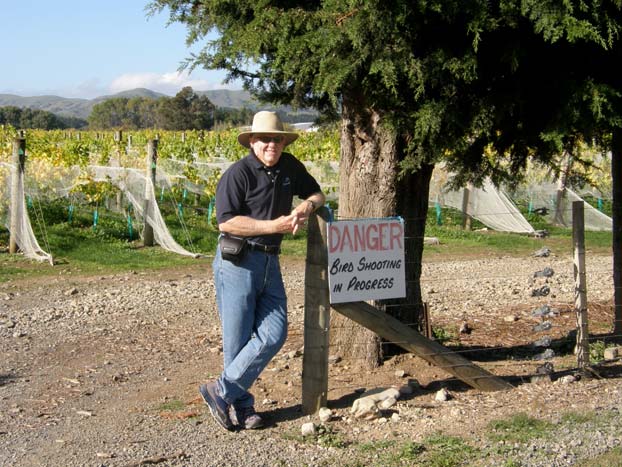
MartinboroughCentral Otago has received much of the press in recent years, but many wine cognoscenti believe that the Martinborough subregion of the Waiparapa shows the most potential in New Zealand for delivering Burgundian character in Pinot Noir. Waiparapa, or ‘The Land of Glistening Waters’, was reputedly named by Kupe, the Maori navigator that is said to have discovered New Zealand. A pastoral area spotted with boggy swamps, Waiparapa consists of a long valley of ancient gravels carved out by rivers that ages ago flowed from the Tasman Sea. It is the driest region of the North Island. Modern viticulture originated thirty years ago in Martinborough, when the area consisted of a small Victorian town laid out in the pattern of the Union Jack and miles of surrounding barren land. Hardly anyone had any interest in the region known for its cold winds and daunting frosts and most thought it was only suitable for sheep grazing. Today, it shows a remarkable renaissance with 39,000 acres of vines, 38 wineries, gourmet restaurants, art galleries, and numerous boutique lodgings. The restored historic Martinborough Hotel (Est. 1882) now anchors proudly this quaint town. Martinborough is a fifty minute tortuous drive over the steep and scenically dramatic Rimutaka Hill from Wellington, the capital of New Zealand. The drive does not deter Wellington residents who flock to Martinborough on weekends to take in the wine related activities making Martinborough the only “wine town” in New Zealand. Toast Martinborough, which began in 1992, is the most popular wine and food festival in the country.
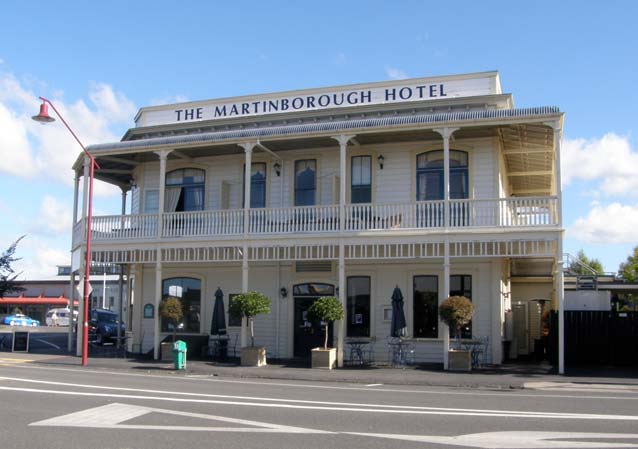 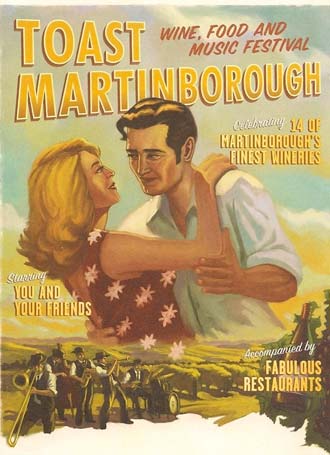 The first vineyards were planted in Martinborough in 1978 by Alistair Taylor at about the same time that a report by Derek Milne was published which identified the stony terraces around town as ideal for viticulture. By the early 1980s, the area had five mainstay wineries, Ata Rangi, Te Kairanga, Chifney, Dry River and Martinborough Vineyard. The second wave arrived in the late 1980s including Palliser Estate, and the third wave followed in the 1990s with the arrival of Escarpment and the Craggy Range Vineyards at Te Muna.
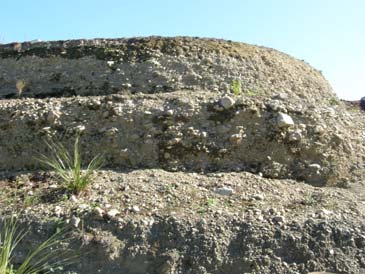 Martinborough’s alluvial river terraces of deep, free-draining gravel overlaid with gravely silt loam are ideal for growing Pinot Noir. A cross sectional photo at Escarpment reveals the typical soil profile. The climate is conducive as well, with low rainfall, warm, dry summers and a long, reliably dry autumn. The weather can be unpredictable, however, with a significant threat of frost and bad weather always looming early in the growing season. The cool evenings during the growing season allow the grapes to retain acidity, although acid is often added during winemaking. Combined with low yields and a focus on quality, the region has received international recognition for producing top quality Pinot Noir and other varieties such as Chardonnay, Riesling and Sauvignon Blanc. Vineyard plantings have spread beyond Martinborough into the other two subregions of the Waiparara, Gladstone and Masterton. Phylloxera is found in many wine growing areas in New Zealand, and last year it was discovered in the Wairarapa wine region. According to the Dominion Post, the mite had infested 61 acres of ungrafted grapevines at Matahiwi Estate in Masterton. 24 percent of the vines in the Wairarapa are on ungrafted rootstock so the threat of spread is serious. It was not known how the insect was spread to the region but probably through plant material or soil brought in on vehicles from affected regions. Most vineyards that do not have resistant vines are planning to replant over the next 10 to 15 years. Strict adherence to rules restricting movement of vineyard machinery and plant material has been instituted (see photo at Dry River below).
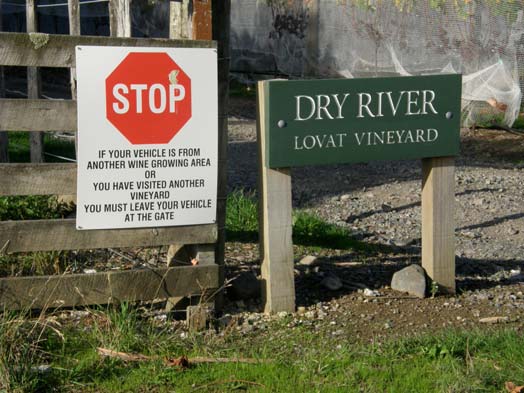
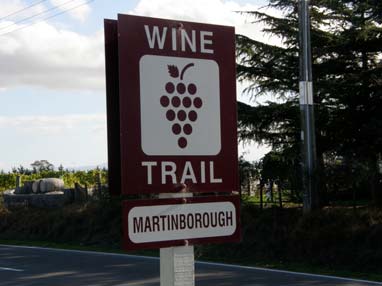 Visiting wineries in Martinborough harks back to a simpler and less hurried time that we have long forgotten in California. The wineries are unpretentious and very modest, offering a friendly reception to all visitors. The tasting rooms (called Cellar Doors in New Zealand), are simply outfitted and do not offer hats and t-shirts and other wine paraphernalia. A number of wineries have restaurants and some even offer accommodations. Martinborough is particularly suitable for visitors, with twenty wineries within walking distance of each other. When I visited, there were no cars on the roads to speak of and very few Cellar Door tasters. As my wife and I meandered along the grassy embankments of the two-lane roads exploring the region, we were shocked when a cheerful woman stopped, got out of her car (she was barefoot by the way) and asked us if we needed directions or a lift. This would never happen in California wine country. If you decide at some time in the future to visit Martinborough, I can highly recommend you hunker down at Parehua, which offers surprisingly modern luxury accommodations and beautifully landscaping within a short walking distance of the town of Martinborough and the surrounding wineries
 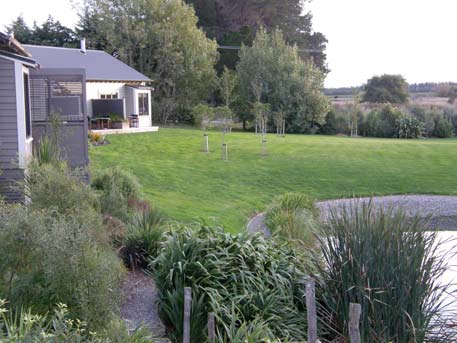 For more reading on the Waiparara, consult the excellent book A Toast to Martinborough and the Wairarapa written by noted New Zealand wine writer, Dave Cull (published in 2003 by Longacre Press, New Zealand, $36.99). For information on the Waiparara, consult the following websites: www.wairarapa.co.nz, www.wairarapanz.com, and www.martinboroughnz.com.
Dry River: Martinborough’s Cult WineDry River was the name of one of the oldest Wairapa sheep stations in New Zealand, dating to 1877. Dry River was later named Dyerville, and it was near here in 1979 that Neil and Dawn McCallum planted a vineyard. This area subsequently became known as the Martinborough Terrace, located just across the Huangarua River from Te Muna. In 2002, the winery and 30 acres of vineyards was sold for the astonishing price of $7 million to New York business man Julian Robertson and California winegrower Reg Oliver who owns El Molino Winery in St. Helena, California. The new owners have infused cash into the operation for expansion and updated equipment. Neil McCallum remains the chief winemaker.
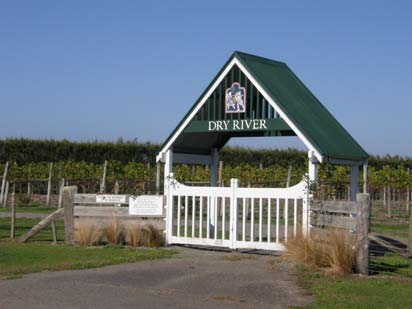 Three features of vineyard management at Dry River contribute to the style here. No irrigation is employed, despite the low rainfall, causing roots to forge very deep for nutrients, stressing the vines and producing small berries with concentrated flavors. Second, leaf stripping is done very early in the season to expose the grapes to the sun and promote phenolic ripeness. Third, crop thinning is done at veraison to severely limit yields. McCallum, whose has a doctorate in chemistry and has pursued research in grape and wine chemistry for many years, comments on the resulting style of his wines: “My suspicion is that New Zealand and cool maritime climates could have a large impact on the world perception of what Pinot Noir is capable of, although it will take some time before the new styles are completely accepted because Burgundy has been center stage for so long. Our own terroir can yield a predominance of plump, exuberant fruit flavors - to a fault in some instances, but they can also be rich and complex varietal statements. Add concentration and longevity to this and great wines are possible.” McCallum is a committed “terroirist” whose writings under the “Jottings” heading on the Dry River website support his philosophy. When you have some leisure time, visit the Dry River website at www.dryriver.co.nz, open a good bottle of Pinot, and savor these excellent essays. McCallum’s wines have achieved cult status in New Zealand, although he never submits the wines for judging. The wines are quickly sold to an eager mailing list, with many more hopefuls on the waiting list. There is no tasting room but an annual prerelease tasting is offered to mailing list customers. The range of wines is remarkable and includes besides Pinot Noir, Chardonnay, Gewürztraminer, Pinot Gris, Riesling, Sauvignon Blanc, Viognier, and Syrah. The wines are known for their longevity. A tasting that McCallum staged with Bob Campbell MW in 2004 and reported in The World of Fine Wine (Issue 19, 2008) revealed that older vintages dating back to 1989 were still youthful and the 1991 vintage Pinot Noir was “By no means at the end of its life.” Campbell described the wines as showing “high levels of flavor intensity and ripeness, impressive longevity, and lower-than-average alcohol levels.” McCallum uses little oak (20%) and the Pinot Noirs have high levels of fruit tannins. The wines begin to open up in 3-4 years.
2004 Dry River Martinborough Pinot Noir 13.0% alc., $70, numbered bottles, cork closure. McCallum reported that in 2004 only a few frosts were met with (helicopter protection was used only three times) and there was no damage to the flowers. The growing season was wet but conditions were consistently warm producing solid cropping levels and boosting phenolic ripeness. A more forward wine than the expected to be long-lived 2003 vintage. · A darkly colored wine with a heady nose of black cherries and plums with a smoky oak accent. Fig, prune, black cherry and plum flavors on the doorstep of overripeness but never crossing the threshold. The complexity is astonishing with exotic spices and a number of flavors I have never encountered with Pinot Noir. An epiphanic wine that was the best Pinot Noir I tasted among all the wines from New Zealand reviewed in this issue.
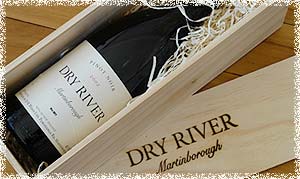 2003 Dry River Martinborough Pinot Noir 13.0% alc., $70, numbered bottles, cork closure. The 2003 vintage at Dry River was very dry and yields were small. The fruit for this wine was harvested at 1.2 tons per acre. · The color is a strikingly dark violet. A deep and rich nose features ripe cherries, raspberries, vanilla and smoke. The mouth feel is very big and plush with generous amounts of sweet fruit. The finish is clean and lengthy and echoes licorice, dark stone fruits, and pleasing oak. The wine has an impressive backbone of acidity and tannins. A Pinot Noir with very powerful charisma. (Reviewed October 13, 2006)
Dry River wines are imported in tiny quantities by RO Imports, St. Helena, CA who sell direct to consumers (www.rowines.com). Check www.wine-searcher.com for retail sources on the internet.
Escarpment Vineyard: Distinctive Terroir, Magical WinesThe Escarpment winery and vineyards are sited above a steep cliff carved by the Huarangarua River over thousands of years. The vineyards are overlooked by the Aorangi Ranges. As legend would tell, Maori navigator Kupe abandoned three canoes there after discovering the land now known as New Zealand. The upturned canoe shapes are clearly visible on the skyline high above the winery. Resting on 60 acres of alluvial gravel in the expansive Te Muna Valley hear Martinborough this is really a magical place. Te Muna translates from the Maori language as ‘special place or ‘secret’. The ancient alluvial soils which are over 75,000 years old are a nurturing matrix for grapevine roots. The soil and the well balanced climate combine to ripen the grapes very slowly. About 70% of the vineyards were planted to Pinot Noir in 1999 to 2001. Close planting is the norm.
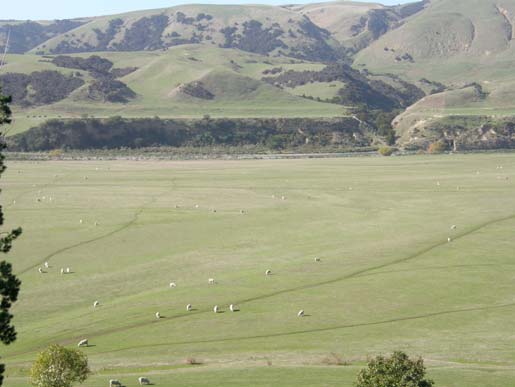 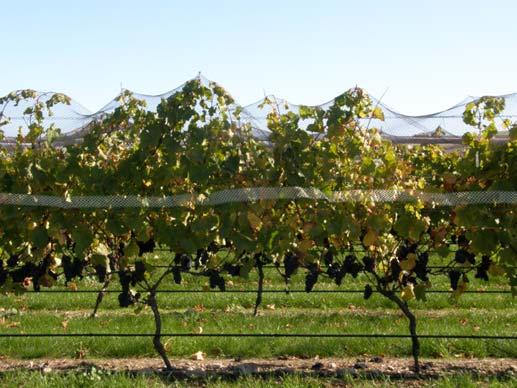 Established in 1999, Escarpment Vineyard Martinborough Limited is a joint venture between Larry and Sue McKenna of Martinborough, and Robert and Mem Kirby of Australia ( who also own Yabby Lake in the Mornington Peninsula of Australia and most notably, Village Roadshow Productions). The company’s vineyards provide 70 percent of Escarpment’s grape supply. Besides Pinot Noir, Pinot Gris, Pinot Blanc, Chardonnay and Riesling are planted. The winery buildings are modest and inauspicious, standing watch on the renowned Martinborough River Terraces and overlooking the river itself (see view from the winery above). The barrel room is tucked underground and enjoys cool and humid conditions below its grassy roof.
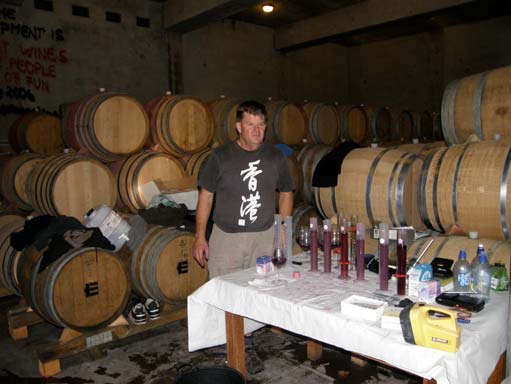 The driving force behind Escarpment is Larry McKenna. Larry grew up near South Australia’s famous Vale and graduated from Adelaide’s prestigious Roseworthy College. He has been a pioneer winemaker in the wine region of Martinborough since 1986 when he became the winemaker at Martinborough Vineyards. Larry has a deep passion for Pinot Noir. James Halliday anointed Larry “The Prince of Pinot,” not realizing that the title was already taken. Larry’s philosophy is summarized as follows: “I want to set new directions (especially for Pinot Noir) creating wines of complexity, texture and structure. Our wines are different, full of surprise and perhaps even unconventional. We are proud of our flagship Escarpment Pinot Noir now, but our wines can only get better with aging vines.” There are three lines of wines produced at Escarpment. The Edge is aimed at younger drinkers and those who prefer buying wine by the glass. These blended wines (currently Pinot Noir and Pinot Gris) are made from various vineyards or districts in New Zealand and are not currently available in the States. The Escarpment wines are premium district blends exclusively from Martinborough. These wines include classic varieties such as Pinot Noir, Chardonnay, Pinot Gris, Riesling, Pinot Blanc and Viognier. The Single Vineyard Wines are the supreme expression of Larry McKenna’s winemaking skills. They are a limited range of red and white single vineyard wines christened “Martinborough Insight Series.” Beginning with the 2006 vintage, three new sites in Martinborough have been added to the estate Kupe Vineyard on Te Muna Road. These wines allow for individual vineyard expression from distinctive sites utilizing some of the oldest vines in the district. In addition to the Kupe estate vineyard, there are bottlings from Moana Vineyard (clones UCD 5,6 and 13 planted on Gill Cleland’s Vineyard in 1989), Te Rehua (several clones grown on the Barton Vineyard from vines over 20 years old), and Voyager (grown on the McCreanor Vineyard, one of the oldest vineyards in the district - clone 10/5 on its own roots).
 Larry graciously invited me taste through several of the Escarpment wines including the inaugural 2006 single vineyard Pinot Noirs. He was candid with me, noting that his wines were not bashful, rather wines with their chest stuck out, strutting lush fruit and rich flavors. I was impressed by the harmony of the wines which were deeply colored and not nearly as extracted as many popular California Pinot Noirs. He told me that the single vineyard Pinot Noirs were picked at about 24 degrees Brix. My brief impressions of the wines follows.
2006 Escarpment Martinborough Chardonnay 14.2% alc.. Barrel fermented. · Smoky and mineral-imbibed white fruits on the nose. Peach, citrus, apple flavors with lively acidity on the finish.
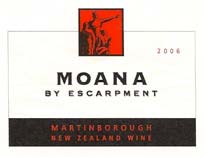 2006 Escarpment Moana Martinborough Pinot Noir 13.5% alc.. Open topped fermented in traditional cuves, hand plunged, total vat time 16 days. Aged in 30% new French oak for 12 months. Fined with egg whites. · A little good barnyard and diaper scent enhancing the crushed plum nose. Dark, dark black cherry, spice, earth, meat and soy with a lengthy and vibrant smoky finish.
2006 Escarpment Te Rehua Martinborough Pinot Noir 13.0% alc.. Open top fermented in traditional wood cuves, hand plunged, with a total vat time of 15 days. Matured in 30% new French oak barrels for 12 months. Fined with egg whites. · The darkest of the single-vineyard lineup. A sturdy and structured wine that offers lovely darkly fruited and floral scents accented by restrained oak toast. Delicious raspberry fruit, generously oaked displaying a clean and refreshing finish.
2006 Escarpment Voyager Martinborough Pinot Noir 13.9% alc.. Open top fermented in traditional wooded cuves, hand plunged, with a total vat time of 19 days. Matured in 30% new French oak barriques for 12 months. Fined using egg whites. · Massive concentration and substantial tannins with great verve. Still unevolved yet showing great potential. Grassy, doughy and chunky with thick wood flavors.
2006 Kupe Single Vineyard Martinborough Chardonnay 14.1% alc.. Barrel fermented. · Lovely aromas of citrus and tropical fruits. Nicely structured mouth filling fruits. More of everything here - more fullness, more smoothness, and lip-smacking minerality.
2006 Escarpment Martinborough Pinot Noir 14.0% alc., $35. · Extremely dark reddish purple in color. Fragrant and showy dark fruit and earthy aromas. Vibrant fruitiness in a chewy, muscular style but very user friendly. Saucy, fat and lush with moderate tannins, a soft texture and a clean finish.
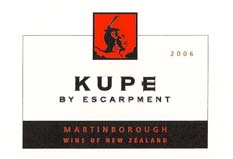 2006 Escarpment Kupe Martinborough Pinot Noir 14.1% alc., $60. From a close planted (16,500 vines/) vineyard. Fermented in wooden French cuves, hand plunged and aged in 50% new French oak barrels. This is the vanguard of the Escarpment style and has admirable age ability. · Gorgeous perfume and fruit featuring bright and fresh dark stone fruits and violets. The palate is soft, plush, long and tasty. This is a compelling wine with mouth-coating tannins and immensely satisfying Pinot fruitiness.
2005 Escarpment Martinborough Pinot Noir Dark fruits particularly plum with a hint of alcohol on the nose. Darkly fruited and well-structured with grassy and herbal notes. Grainy tannins and a clean, dry finish.
Escarpment wines are imported to the United States by Empson USA, Inc., Alexandria, VA (www.empsonusa.com). The Escarpment and Kupe Pinot Noirs are most available and represent quintessential examples of Martinborough Pinot Noir. Visit the website at www.escarpment.co.nz.
Central OtagoCentral Otago’s viticultural history began with John Desire Feraud, who was attracted to the area during the Dunstan gold rush of 1862. Feraud came from a French winemaking family, quickly recognized the potential of the area for grape growing, and planted the first wine grapes in Central Otago in 1864. Over the next twenty years he made a variety of wines, some winning prizes in Sydney wine competitions. When he left the region, commercial winemaking ceased and wasn’t revived until experimental plantings were farmed by Rolfe Mills in 1975 in the Wanaka area. Mills later planted the Rippon Vineyard in 1982, the first commercial vineyard in Central Otago since the gold rush days. The first commercial release of Pinot Noir from Central Otago was the 1987 vintage from pioneer Alan Brady at Gibbston Valley Winery. Other early pioneering wineries include Taramea, Black Ridge, William Hill and Chard Farm. Felton Road was the first major vineyard and winery in Central Otago (established in 1991), and by 1997 was releasing wines that were startling, bringing international attention and notoriety to Central Otago. Central Otago is the most southerly wine region in the world located at 45-47 degrees latitude, the same latitude as Burgundy and Oregon’s Willamette Valley in the northern hemisphere. It the fastest growing wine district in New Zealand. In 1997, there were only 500 acres of vines and 14 wineries in Central Otago. By 2007, there were 89 wineries and more than 4,000 acres planted to vines, at least 70% of it Pinot Noir. Because of its inland location and significant distance from the ocean, its climate is continental. Snowcapped mountains are a prominent part of the landscape in winter, but the sun shines brightly during the summer and autumn. Very little rain falls in Central Otago per se, but the surrounding country is quite wet so that water is readily available. Milford Sound, which is only an hour helicopter ride away, is the wettest place on Earth receiving around 28 feet of rain per year! Central Otago wine country is the closest thing to a desert in New Zealand. Milford Sound, of course is one of the natural wonders of the world and must be experienced by anyone traveling to Central Otago. On our trip in April, my wife and I took a helicopter ride to the Sound, followed by a boat ride along the scenic water inlet. I must say, this was the most breathtaking scenery I have ever laid eyes on. The photos below show us after landing on a glacier at 7,000 feet and later taking in the steep cliffs dotted with waterfalls along both sides of the Sound.
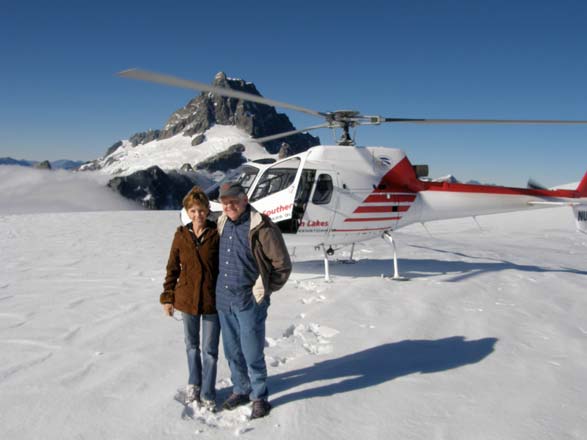 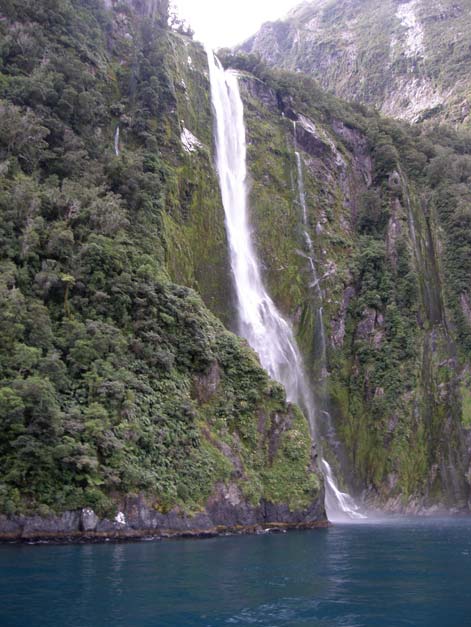
Pinot Noir thrives in Central Otago because even though the growing season is not lengthy, the absence of a wet maritime influence allows tannins to ripen and acidity to be retained without sugars becoming excessive. The river silts, clays, loams and sands that make up the soils are interspersed with ground schist rocks and are therefore free draining. The low rainfall has kept leaching effects low, so there is a good level of mineral compounds present, but low rainfall has restricted plant growth, so the organic content of the soil is low. The result is soil low in vigor, but high in minerality. Irrigation is a necessity and is finely tuned to keep the vines tuned to the desired degree of stress. The winters are cold and dry with snow not unusual on the flatlands, and a constant threat of spring frost is present. The low humidity and low rainfall greatly reduces Botrytis pressure. Large diurnal shifts are the norm. There are six subregions in Central Otago’s rugged mountain landscape and all have distinctive microclimates. Lowburn, Bendigo, and Bannockburn are part of the Cromwell basin which accounts for 70% of the region’s vineyards. Gibbston is closest to Queenstown and here plantings are found on terraces above the Kawarau Gorge. The remainder of the vines are located in Alexandra, the most southerly subregion, and around Wanaka in the North. About half of the Pinot Noir produced in Central Otago is made by wineries or by cooperatives, while the other half is put into Central Otago blends. The largest winemaking contractor in Central Otago is the Central Otago Wine Company where master winemaker, Dean Shaw, produces wine according to each label’s specifications.
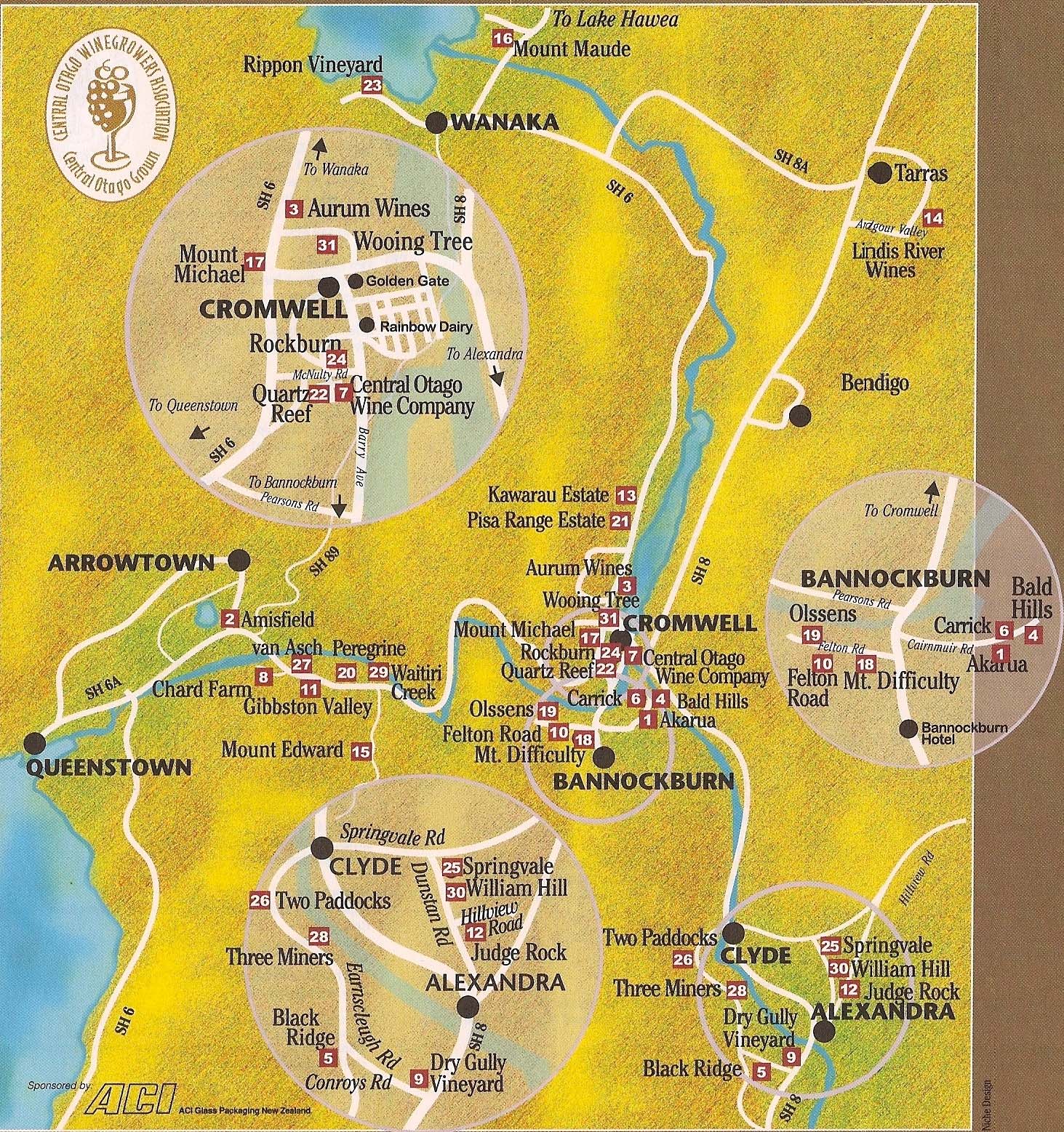
Rippon Vineyard & Winery: Wines To Match the SceneryThe history of Rippon has been alluded to in this issue and goes back to the 1970s when Rolfe and Lois Mills began to experiment with Vitis vinifera plantings in Central Otago. This was a challenge, since the only vineyards in New Zealand at the time were on the North Island near Auckland, Hawke’s Bay and Gisborne. There was no local source of equipment and Rolfe had to make do with what was available. Standard-sized tractors, for example, needed to be narrowed to fit inside the rows of planted vines. Rolfe was a true visionary and Kiwis speak of him in revered tones as the father of Central Otago viticulture. In 1982 he developed the first commercial planting of Vitis vinifera along the shores of Lake Wanaka. Rippon is part of what once was a large high-country farm, Wanaka Station, which was bought in 1912 by Sir Percy Sargood, the great-greatgrandfather of the current Mills generation. Emma Rippon was Percy’s grandmother, after whom the vineyard was named. The vineyard at Rippon was quite successful because its location in close proximity to the Great Divide range of mountains and Lake Wanaka (a large thermal mass) results in a slightly more temperate microclimate relative to the rest of Central Otago. The threat of frost is markedly reduced due to the influence of the stunning lake. The metamorphic, schist-based soils rich in foliated mica and quartzite on the property are ideal for grapevines. By the early 1990s. Rippon Pinot Noir was winning worldwide recognition and in 1992 was awarded the trophy for New Zealand’s best red wine. Rolfe became the founding President of the Central Otago Winegrower’s Associated. Rippon’s success spawned a number of other successful wineries in the region, including Felton Road, Mt. Difficulty and Olssens, all of which were much better funded than Rippon and attracted bright and well-trained winemakers and winegrowers. Gradually Rippon fell behind, the wines languished and Rolfe passed away in 2000. It was young Nick Mills, Rolfe and Lois’s son, who came to the rescue and has guided Rippon back to the upper echelons of the New Zealand wine industry. I spent some time talking with Nick and found him to be an impressive young man of fortitude and conviction, much of it developed on the snowy slopes of his beautiful country. Nick became a champion snow skier and was the best in New Zealand at one time. Unfortunately, he blew out a knee just months before the 1984 Olympics. Disappointed and disillusioned, he traveled to France where he had fond childhood memories of trips spent with his father who was learning about viticulture firsthand. On these trips, Nick had picked up French so when he returned he was able to converse. He says he didn’t know a sole and was lucky to get a job as a cellar rat at Domaine Jean-Jacques Confuron in Burgundy. He ended up staying in France from 1998 to 2002, studying at the CFPPA de Beaune and working in some of France’s most celebrated estates including Maison Nicolas Potel, Domaine de la Vougeraie, Domaine de la Romanee-Conti and Domaine Albert Mann. He never really considered returning to New Zealand, and infact, he was thinking about going to Oregon when he received a phone call from his mother in 2002 asking him to come back and assume management of Rippon. He hesitated for a few months and then, “duh,” he realized that he really belonged at Rippon and saw the need and challenge to guide Rippon back to its former glory.
 Today, Rippon continues as a family run operation with Nick Mills directing the estate as winemaker and viticulturalist , Jo Mills (Nick’s wife and a recent mother) manages marketing and exportation, David Mills (Nick’s older brother) takes care of the property’s machinery and headlands, and Charlie Mills (Nick’s younger sister) acts as vineyard manager. The latest addition to the family business is Toby Ford Sargood Mills (also known as Ziggy), who signed on en primeur on September 14, 2008 (right). Rippon’s vines are among the oldest in the region with most plantings dating to 1985-1991. 80% of the vineyard is planted on its own roots and is not irrigated. Pinot Noir comprises 40% of the plantings and the clones are Pommard, 10/2, 10/5 and Lincoln. The vines at Rippon have always been farmed organically, but upon Nick’s return the entire property was converted to biodynamie. No soluble fertilizers, herbicides, fungicides or pesticides are used. The property produces and spreads around 52 cubic yards of compost every year. The photo below shows Nick proudly showing us his compost pile. Nick is passionate about biodynamics and is committed to putting as little into the property as possible and in return taking as little out as possible. The family has worked the land at Rippon for four generations and the family’s aim is to keep the land alive in order for it to be vital for another four generations or more.
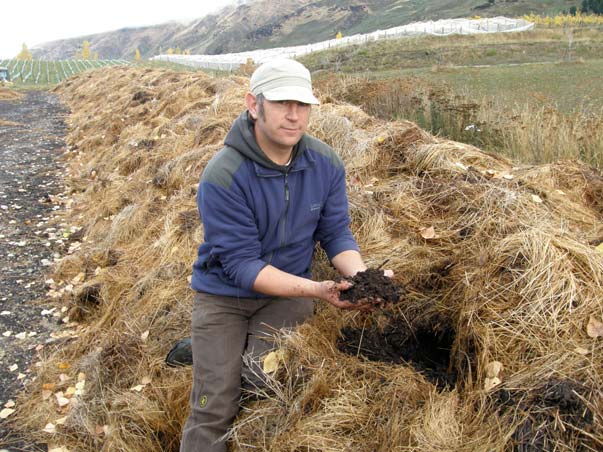 All Rippon wines (Pinot Noir, Chardonnay, Gewürztraminer, Muller Thurgau, Osteiner,Riesling, Sauvignon Blanc, Gamay and a small amount of Shiraz and Merlot ) are from the 30-acre estate vineyard. The different clones, vine ages and micro-sites within the vineyard are picked and fermented separately. 10-12% whole clusters are used. Natural yeasts drive fermentation which starts about the 8th-10th day of cuvaison reaching dryness in 13-18 days. Most ferments are given extra time on skins post-fermentation making total time of skin contact 17-23 days. The Pinot Noir spends two winters (16-18 months depending on the vintage) in 25% new French oak barrels and is bottled without fining or filtering. Rippon Riesling and Pinot Noir are cellared in bottle for one year before being released to the market (the current vintage on the market is 2005).
I visited on an overcast day but the photo below (and the one shown earlier) give you an idea of why this is the
most photographed vineyard in the world and often appears on new Zealand wine promotional literature.
Of course, every winery has to have a dog and Rippon is no exception. Pipi (The Ratbag) followed us around as we toured the vineyards. He was camera shy.
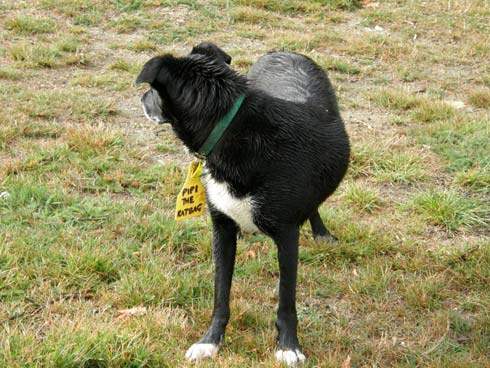 The structures on the Rippon property are very unpretentious. The winery is located inside an old goat shed. Nick has plans to build a gravity flow winery on a vacant hillside in the middle of the vineyards. The tasting room (pictured below) is tiny.

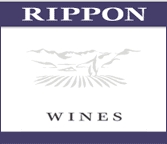 2005 Rippon Lake Wanaka Central Otago Pinot Noir 12.8% alc., $45. · Well spiced cherries with an edge. On the palate the wine has good grip with mediumweighted flavors of red cherries, baking spices, and a hint of oak. Very tame tannins. Excellent persistence on the finish which features a citric cherry tang. This wine will find many fans for its modest alcohol and food-friendly zippy acidity.
Rippon wines are imported to the United States by Penny and Andy Loving of Station Imports, Colorado Springs, CO. 719-651-9898. The website is www.rippon.co.nz.
Felton Road: Critically Acclaimed WorldwideTravel to the end of Felton Road in Bannockburn, Central Otago, and you come upon a very modest and unpretentious building housing a winery and tasting room. Once inside, however, you will find a lineup of wines of uncommon polish and sophistication. It is here that brilliant winemaker Blair Walters plies his trade, committed to the notion that any wine worth making is worth making fanatically. The accolades have been forthcoming worldwide since the first releases in 1997. Robert Parker, Jr., proclaimed, “Felton Road’s Pinot Noirs are breakthrough efforts in New Zealand and compete with the finest wines being made in California, Oregon and Burgundy’s Cote D’Or. Matthew Jukes of Expertwine.com said, “I can confirm that this is the single most impressive estate in New Zealand. Each and every wine is fantastic.”
 The wines (Pinot Noir, Chardonnay, Riesling) are produced exclusively from the estate’s 80 acres of vineyards over three sites. The Elms Vineyard (photo above of Block 3 viewed from the tasting room deck and map below) consists of 36 acres, and was planted in two phases. Blocks 1-9 date to 1992-1994 and Blocks 10-13 were planted in 2001. There are varying vine densities, clones, rootstocks and cover crops. Research by Stewart Elms in 1991 identified the North facing slopes at the end of Felton Road as being ideal for growing premium grapes. All vineyard sections share the same exposure, aridity and elevation but have varying soils. Block 3, for instance, is composed entirely of deep fine sandy loams, the preferred soil for Pinot Noir in Central Otago, of moderate fertility with good water-holding capacity. The Lochar block has shallow fine sandy loam with schist gravel coming all the way to the surface and is best suited for Chardonnay and Riesling. This can be seen on the map to follow as Block 6, planted to Chardonnay. Block 1 is the steepest north-facing slope with heavier soils, best for Riesling.
 The 25-acre Calvert Vineyard was planted from 1999 to 2001 with a range of Pinot Noir clones and rootstocks. It is located a short distance east of Elms Vineyard. The vineyard is leased and fully managed by Felton Road. The 19-acre Cornish Point Vineyard is named after the Cornish gold miners who lived there in the late 19th century. It is uniquely surrounded by water from the Clutha and Kawarau rivers minimizing frost pressure. Soils are moderately deep fine sandy loams with schist. The vineyard is planted in 18 different clone and rootstock combinations.
All vineyards are cultivated biodynamically by Felton Road’s viticulturalist, Gareth King, and his team. Felton
Road wines became fully biodynamic beginning with the 2006 vintage and official certification is in progress.
Nigel Greening, a British native and wine enthusiast who lives primarily in Europe, bought Felton Road in 2000.
He can be heard speaking about Felton Road’s commitment to sustainability and biodynamic farming at this
year’s International Pinot Noir Festival. Listen to it now Felton Road’s winemaker, Blair Walter, told me a humorous story. When he was in enology school, he was the youngest student in the class and was teamed to work with the oldest member in the class, Stewart Elms. Elms struggled in class and depended on Walter to help him through the class. Several years later, Elms asked Walter, who had worked at nearby Rippon, to be his winemaker at Felton Road. Subsequently, Walter traveled to Oregon, examining winery designs throughout the Willamette Valley, and returned to supervise construction of the current modern Felton Road winery. Walter’s winemaking emphasizes a traditional approach, preferring wild yeasts to cultured ones and minimal intervention at all stages of winemaking. The white wines are all hand harvested, whole bunch pressed, with barrel fermented wines being stirred weekly for complexity. Pinot Noirs are fermented outdoors in small fermenters with traditional punch downs and pigeage before aging in barrels from top Burgundian coopers. Barrel aging extends from 11 to 18 months, with the vineyard-designate wines from Calvert Vineyard and Cornish Point Vineyard and those from the older vines in Block 3 and 5 receiving the longest time in barrel. The Felton Road Pinot Noir is a blend of the three different vineyards so it is a mix of vine age and vineyard origin. Block 3 is primarily clone AM 10/5 (or Wädenswil as the Oregonians call the clone). Block 5 is most planted to clone UCD Pommard 5.
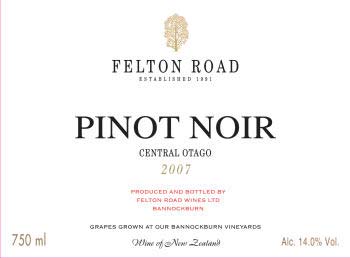 2007 Felton Road Central Otago Pinot Noir 14.0% alc., $40, screw cap. · A beautifully composed wine with a delicious mix of dark berries, plums, earth, anise and oak fanning out vibrantly on the palate. Supple tannins softly surround the fruit, the style is graceful and refined, and the balance is perfect. This wine is more forthcoming than the 2006 vintage (which I tasted at the winery) which still needs to shed its tannins.
2006 Felton Road Calvert Vineyard Central Otago Pinot Noir 13.5% alc., $48, screw cap. Inaugural bottling from the Calvert property. · Lighter crimson in color. Red Pinot fruits star here, particularly Queen Anne cherries. A feminine wine to snuggle up to with soft and persistent fruitiness and a lightly oaked and tangy finish.
2004 Felton Road Central Otago Pinot Noir 14.0% alc., $35, screw cap. · Very interesting and complex aromatic profile featuring ripe berries, rhubarb, grass, wood char, and animale. Lithe and seductive blackberry and black raspberry fruit flavors accompanied by a velveteen texture, gossamer tannins and good grippy finish.
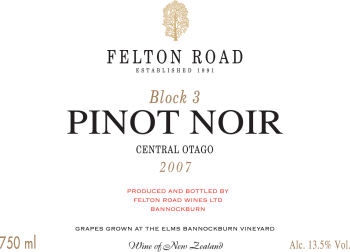 2004 Felton Road Block 3 Central Otago Pinot Noir 14.0% alc., $49, screw cap. · Alluring Bing cherry and raw meat aromas. Dark red fruits dance on the palate with a touch of mocha, herbs, spice and minerals. Less earthy, redder, spicier and brighter than the Block 5. Very smooth and silky with supple tannins and impeccable balance. A spellbinding wine that belongs in the top echelon of the world’s Pinot Noirs.
2004 Felton Road Block 5 Central Otago Pinot Noir 14.0% alc., $49, screw cap. · A big-boned wine with intense flavors that overshadow the restrained aromas of black cherry, blackberry, roasted nuts, herbs and oak. A big gulp of black fruit leads the attack in the mouth, yet the wine is rich, smooth and velvety with a pleasing earthiness and deft use of oak. This wine has a ways to go before it reveals itself completely and should age beautifully for many years to come.
2003 Felton Road Central Otago Pinot Noir 14.0% alc., $35, screw cap. · Demure red cherry scents accented with dried herbs, violets, oak, grilled meat and barnyard. Fairly light in weight and a little tart in the mouth with subtle overtones of earth and oak. Nice elegance but a bit austere and acidic and a touch hot on the finish.
Felton Road wines are imported to the United States by Wilson Daniels, St. Helena, CA (www.wilsondaniels.com) and are readily available in the States. These wines, in particular since 2002, have become benchmarks for Middle Earth Pinot Noir and are priced ridiculously cheap considering the quality. When I visited Felton Road, I tasted through the entire lineup of 2006 releases. The dry Riesling and oaked Chardonnay were very appealing whites. The five Pinot Noirs (Central Otago, Block 3, Block 5, Calvert, Cornish Point) were all stellar and highly recommended. Visit the informative website at www.feltonroad.com. (Blair Walter in his habitat below).
 If you travel to Central Otago, consider timing your visit with the Central Otago Pinot Noir Celebration, held three out of four years (alternating with Pinot Noir New Zealand) on the last weekend in January in Queenstown. Next year’s event will be on January 30-31. For information on New Zealand’s two major Pinot Noir events, visit www.pinotcelebration.co.nz. and www.pinotnoir2007.co.nz/Pinot-Noir-2010. The place to stay in Queenstown is the luxurious Pencarrow B&B. The scenery from every room is breathtaking, the breakfasts feature multiple courses and are both gargantuan and gourmet in style, and the American-born hosts, Bill & Kari Moers are warm, gracious and dedicated to your comfort. I absolutely hated to leave. Central Otago wineries are within an hour’s drive. Visit the website at www.pencarrow.net.
  For more information on Central Otago wines, visit the following websites: www.centralotago.net.nz, www.otagowine.com, www.lakewanaka.co.nz, www.queenstown.co.nz, www.cowa.org.nz and www.centralotagopinot.co.nz.

Small Sips of New Zealand Pinot Noir
I recently sampled a number of Pinot Noirs primarily from Martinborough and Central Otago. All of these wines
are readily available in the United States marketplace.
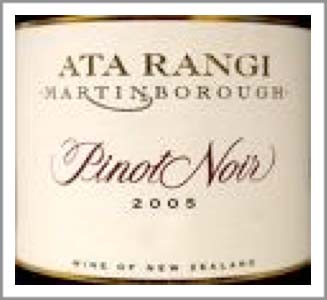 2006 Ata Rangi Martinborough Pinot Noir 13.5% alc., $44, screw cap. Imported by Epic Wines,Aptos. · Lovely and powerful scents of cooked cherries, smoke and baking spice. Medium-weighted black cherry fruits which are slightly tart and accented with tasty oak. Softly textured and nicely balanced with a pleasing cherry persistence on the dry finish.
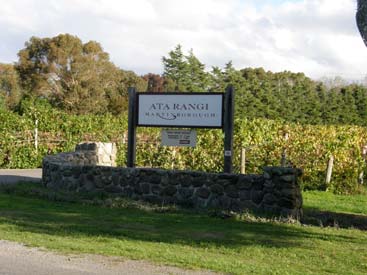 Ata Rangi dates to 1980 when Clive Paton planted his first vines. He released his first wines in 1985, but he struggled mightily early on, growing pumpkins and garlic to help meet financial demands. With the contributions of Paton’s winemaker wife, Phyll Pattie, and highly educated winemaker Oliver Masters who is married to Paton’s sister, Alison, the foursome brought Ata Rangi worldwide recognition, winning the Bouchard- Finlayson Trophy from the United Kingdom International Wine and Spirit Competition three times. Ata Rangi produces a complete line of wines, but Pinot Noir is the star here. The website is www.atarangi.co.nz.
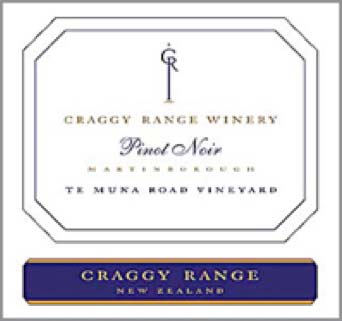 2006 Craggy Range Te Muna Road Vineyard Martinborough Pinot Noir 14.0% alc., $45. Imported by the Kobrand Group, NY, NY. · The nose turned me on and I wanted to dive in. Fragrant melange of red fruits, especially cherries, with a sidecar of brown sugar, grass, earth and wet stones all of which carry over to the juicy flavors. All silk and satin with impeccable balance, perfectly integrated oak, and a notably persistent aromatic finish displaying cherries and raspberries. This is pinotosity exemplified. All world. Tasted twice.
Craggy Range is a partnership between businessman Terry Peabody and accomplished viticulturist Steve Smith MW. Formed in 1998 with the purchase of wine growing land in Hawke’s Bay Gimblett Road subregion, Craggy Range has since acquired several Pinot Noir vineyards in other regions, including Martin’s Road, Otago Station, and Te Muna Road in the Wairarapa region of Martinborough. The 230-acre Te Muna Road Vineyard was planted in 1999 in the Martinborough Terraces subregion of Martinborough, separated from the Terraces by the Huangarua River. The vineyard is largely planted to Pinot Noir, with lesser amounts of Sauvignon Blanc, Chardonnay and Riesling. Craggy Range specializes in single vineyard wines that are produced in limited volumes and represent the most complete expression of the vineyards. American Doug Wiser, a protege of Ted Lemon (Littorai), was the winemaker here until his tragic kite surfing accident in 2004. The current Pinot Noir winemaker working under the direction of Steve Smith is Adrian Baker. Craggy Range is an ambitious project that could only be accomplished with significant financial resources (the vineyards alone are reportedly to have cost $36 million!). Visit the informative website at www.craggyrange.com.
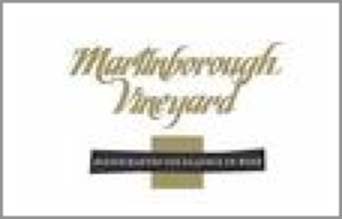 2004 Martinborough Vineyard Martinborough Terrace Pinot Noir 13.5% alc., screw cap. · This lovely Pinot shows off the redder side of Martinborough. Richly spiced cherries on the nose are duplicated in the flavors which add notes of cranberry and oak. Lithe and elegant with a silky mouth feel and a brisk, slightly tart, finish.
2006 Martinborough Vineyard Martinborough Terrace Pinot Noir 13.9% alc., $37, screw cap. Imported by The Sorting Table, LLC, Napa, CA. Clones are Abel, 10/5, 115 and Pommard 5. · A lighter-styled wine with appealing scents of fresh strawberries and Provencal herbs. Subtly oaked cherry and strawberry fruit that is soft in the mouth and bracing on the tangy and woodsy finish. Delicate for a Martinborough Pinot Noir.
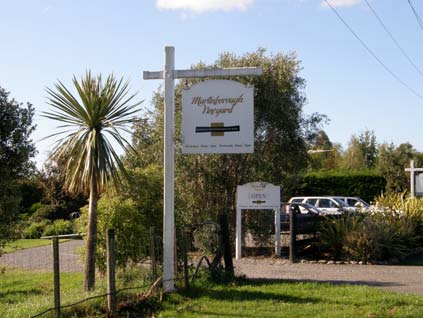 In the 1970s, there were a number of wine tasting groups in Wellington whose members would later strike fame in the New Zealand wine industry. One such wine enthusiast was Dr. Derek Milne, a government soil scientist, who along with a group of five other enthusiasts, bought 16 acres in Martinborough and started Martinborough Vineyard in 1980. Milne was part of a research group that had concluded that Martinborough most closely aligned climatically with Dijon in northern Burgundy. The free draining soils, hot summers and reliable long dry autumn suggested that the area was ideally suited to Burgundian style wines especially Pinot Noir. It was a young winemaker from Australia, Larry McKenna, the first trained wine professional in Martinborough, who joined the partnership and brought Martinborough Vineyard into prominence. Although McKenna had never made Pinot Noir before, his first vintage, the 1986 Martinborough Vineyard Pinot Noir, won gold medals. McKenna stayed until 1990, when he left to develop his own vineyard at Escarpment. Winemaker Claire Mulholland who had experience with Pinot Noir in the Gibbston Valley of Central Otago was hired in 2000. New Zealander Paul Mason joined the winemaking staff in 2004. Today five of the six original enthusiasts remain as the shareholders and four as directors of Martinborough Vineyard Ltd. The winery has a lovely tasting room and grounds and remains a mainstay of Pinot Noir in Martinborough. The website is www.martinborough-vineyard.co.nz. The wines made by Larry McKenna have a track record of age ability. I drank the 1998 Martinborough Vineyard Pinot Noir with Larry while in Martinborough and it was excellent, sporting a lovely secondary bouquet and plenty of persistent juicy fruit with overtones of spice and leather.
2006 Pencarrow Martinborough Pinot Noir 14.0$ alc., $17, screw cap. Produced by Palliser Estate, Ltd., imported by Negociants USA Inc, Napa, CA. · Interesting nose of red cherries, strawberries, smoke and a touch of barnyard. Nicely presented red fruits rubbed with little spice and oak char. Needed about 30 minutes to open up. Easy to drink and would be a fine compliment to lighter fare. Excellent value.
 2005 Palliser Estate Martinborough Pinot Noir 14.2% alc., $25, screw cap. Imported by Negociants USA,Inc., Napa, CA. · Scents of ripe fruit, spiced raisins, anise and oak. Fully developed black cherry fruit with considerable earthiness and oak influence. The tannins arrive with a rush on the finish. I would advise further cellaring of this wine, expecting the hard tannins to soften.
Palliser Estate is the biggest winery in Martinborough and its production overshadows most other producers in the region. The first Palliser Estate wine was made in 1989 by Larry McKenna. The winery was part of the second wave in Martinborough that followed Dry River, Ata Rangi and Martinborough Vineyards. Palliser Estate produces a broad range of white wines along with Pinot Noir including a sparkling wine. I would be patient with the Palliser Estate wines. While in Martinborough I drank a 1999 Palliser Estate Pinot Noir that was still cranking out the good stuff. Pencarrow is Palliser Estate’s second tier brand. The website is wwwpalliser.co.nz.
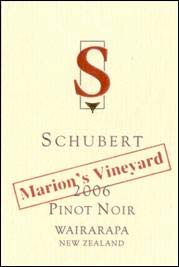 2006 Schubert Marion’s Vineyard Wairarapa Pinot Noir 14.0% alc., 1170 cases, $39. From a vineyard in 1989 on the Martinborough Terrace. 100% de-stemmed. Fermented in stainless steel vats, left on the skins for 3 weeks. Aged in 35% new French oak for 12 months. · Grape and black cherry perfume with a whiff of oak and alcohol. Lovely black raspberry fruit with a subtle and complimentary oak sidecar. Tangy acidity with a hint of citrus peel on the refreshing finish.
Schubert was founded by German Kai Schubert and partner Marion Deimling. In 1998, a small established vineyard was acquired in Martinborough and additional high density planting was started in 1999 with now 36 acres under vines. A small tasting room is located on the property. The website is www.scubert.co.nz.
2005 Voss Estate Martinborough Pinot Noir 14.0% alc., $38. Imported by Meadowbank Estates, Alexandria, VA.I cannot find any reviews of this wine on the winery’s website to buttress my impression. Tasted twice. · Very dark crimson. Port-like aromas with a hint of oak, earth, forest floor, char and smoke. A wood-driven wine fueled by overripe, raisiny fruit. Dark, dry and tannic and surprisingly poor from this well known producer.
Voss Estate Vineyard was established in 1986 by Pinot Noir enthusiasts Annette and Gary Voss. The original vineyard was planted in 1988 and a subsequent vineyard was established to meet the demand for Voss wines. The website is www.vossestate.co.nz.
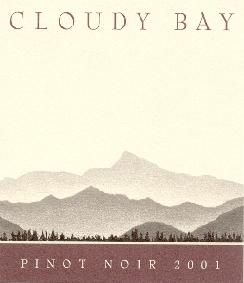 2005 Cloudy Bay Marlborough Pinot Noir 14.0% alc., $32. Imported by Moët Hennessy USA, Inc., NY, NY. · Engaging scents of cherry-berry compote, mushrooms, oak and spice. Soft and light, bordering on shallow, black cherry driven flavors with underlying earthiness, tobacco and a hint of wood. A decent wine that lacks cajones.
2006 Kim Crawford Marlborough Pinot Noir 13.5% alc., $16. Aged in barrel and tank for 5+ months. Imported by Vincor USA, Esparto, CA. Winemaker Kim Crawford has left her eponymous winery, which was acquired by Constellation Brands in 2006 through the company’s purchase of Vincor. Winemakers Matt Large and Jules Taylor will take over. · Delicate red fruits, dried herbs and a little grassiness on the nose. Tasty red fruits which are a little leafy with some oak running through. Very light and elegant with a slightly dry and tart finish. A good daily drinker.
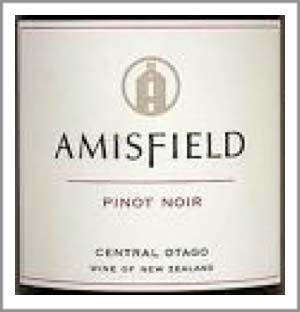 2006 Amisfield Central Otago Pinot Noir 13.9% alc., $33, screw cap. Imported by Pasternak Wine Imports,Harrison, NY. From single vineyard estate fruit. Partly barrel fermented with some whole clusters and part tank fermented with native yeast. · Deep crimson color. Opens with dark plumy fruit, oak and a kiss of dark toast. With air, many surprises unfold including redder fruits, caramel and a little good Pinot funk. Fairly light-bodied and very smooth and pristine to the finish. Juicy strawberry, persimmon and oak flavors. An immensely satisfying drink with plenty of charm.
Amisfield Wine Company uses sustainable practices at the Amisfield Vineyard located a short distance north of Lowburn near the shores of Lake Dunstan. Planting started in 1999 and consists of 150 acres of Pinot Noir, Pinot Gris, Riesling and Sauvignon Blanc. The vineyard sits in glacial and alluvial schist soils at the foot of the Pisa Range. Australian Jeff Sinott has been the winemaker since 2001. The Pinot Noirs have had consistent success at wine competitions and in 2004, won the award for Best Pinot Noir at the San Francisco International Wine Competition (the winning wine was the Amisfield 2002 Pinot Noir). A modern winery was built at the Lowburn Vineyard in 2006. The winery maintains a spectacular tasting room and Bistro art Lake Hayes, just a 10 minute drive from Queenstown. When I visited, Amisfield was hosting an ambitious exhibition of outdoor kinetic and surreal sculpture by sculptor Phil Price. The website is www.amisfield.co.nz.
 2006 Aurum Wines Mathilda Reserve Central Otago Pinot Noir 13.9% alc., $36, screw cap. Imported by Via Pacifica Imports, Sebastopol, CA. A reserve wine named after the first born child of the winemakers. Matured in French oak for 10 months. · Very fragrant red fruit and baking spices. Delicate and silky with admirable elegance. The red fruits are demure and want for intensity. Currently the nose trumps the flavors but this one deserves another look in several months.
Aurum is a boutique family estate with two vineyards on the shores of Lake Dustan in Lowburn planted in 1997 and 1998 and Te Wairere Vineyard near Cromwell planted in 2001. Established in 2002 by Joan and Tony Lawrence, all Aurum wines since 2006 come from estate-grown grapes. A tasting facility is open daily during summer months. The website is www.aurumwines.co.nz.
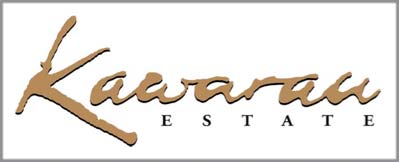 2006 Kawarau Estate Central Otago Pinot Noir 13.5% alc., $30, screw cap. Imported by Station Imports LLC, Colorado Springs, CO. · A complex wine with plenty of things going on, but the fruit never really comes to the forefront. Lean cherry, grass, earth, smoke, oak and a little vinegar scents. Earthy, grassy, woody and a touch green overshadowing the cherry core. Pushy tannins on the finish.
2006 Kawarau Estate Reserve Central Otago Pinot Noir 13.5% alc., $40, screw cap. · Dense reddish-purple color.Sturdy nose of toast, plum, blackberry jam and smoke. A ramped up, big and chewy wine that is all about extracted fruit. The tannins are nicely tamed and the mouthfeel is soft. A woody, green edge mars the finish. Trying for too much here. This wine could be from anywhere.
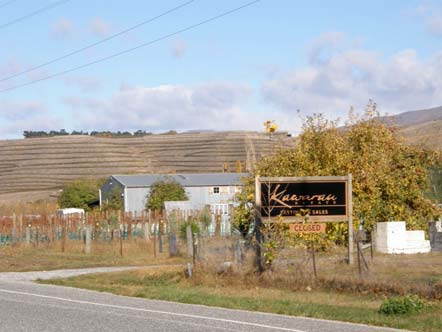 Kawarau Estate’s family owned estate vineyards are located against the foothills of the Pisa Range, an area where gold miners of the 19th and early 20th centuries roamed. The labels depict some identities from the Central Otago gold mining era. The wines are open vat fermented and aged for 10 months in French oak barrels (the Estate uses 1 to 5 year old barrels, the Reserve about 25% new barrels). Wild yeasts drive the ferments and minimal fining and filtration is used. The two wines here reflect the 2006 vintage’s long very hot summer.
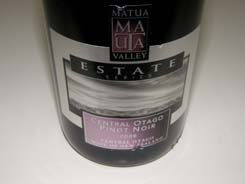 2006 Matua Valley Estate Series Central Otago Pinot Noir 13.5% alc., $17. Imported by FWE Imports, Napa, CA. Sourced from Gibbston Valley. · Dark reddishpurple color. The aromas are from the dark side showing plenty of forest floor, oak, toast and shroom. Black berry and stone fruit flavors are earthy and tinged with oak and herbs. A good value wine, nicely crafted with nothing out of place.
Matua means “lead of the family” in Moari. Bill and Ross Spence were sons of a winemaking father. Ross trained in California, Bill in New Zealand. They began modestly in a tin shed in West Auckland in 1974. Success came quickly and by 1976 a partnership had formed with another Auckland family, the Margans. Located in the Waimaku Valley, 30 minutes from Auckland in the North Island. When the Margan family decided to depart, Matua Valley partnered with the Australian company, Fosters and its wine division, Beringer Blass. This winery produces varieties sourced from estates throughout New Zealand as well as their own vineyards in Waikoukou Valley near Auckland. Visitors are welcomed at Cellar Doors in Auckland and Marlborough. The website is www.matau.co.nz.
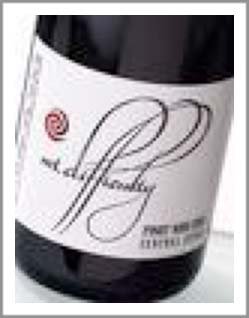 2006 Mt. Difficulty Central Otago Pinot Noir 14.5% alc., $27, screw cap. Imported by American Inc, Phila, PA. From vineyards on the banks of the Kawarau River in Bannockburn. Some whole clusters used. · Fairly shy black cherry aromas shaded by savory herbs. Wood-fired dark red fruit with a mildly dry and citric finish.
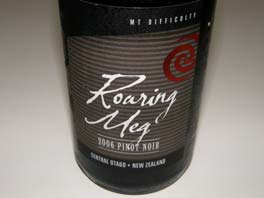 2006 Mt. Difficulty The Roaring Meg Central Otago Pinot Noir 14.5% alc., $17. Named after a local streamrich in history and character. From several vineyards. Aged 10 months in French oak. Mt. Difficulty’s second label. · Nicely oaked black cherries, herbs, allspice, candy apple and warm oatmeal cookies on the nose, dancing and changing constantly in the glass. Very nicely composed with rick dark red berries complimented by oak toast. Smooth and clean with fine grained tannins. A very satisfying drink that I preferred over the more expensive bottling.
Mt. Difficulty’s vineyards are situated in Bannockburn south of the Kawarau River and were established in 1992. All the wines are from vineyards supervised by the Mt. Difficulty management team. Winemaker Matt Dicey has been at the helm since 1999. A tasting room (cellar door) with panoramic views and a cafe invite visitors to the winery located on Felton Road in Bannockburn. The website is www.mtdifficulty.co.nz.
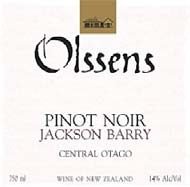 2004 Olssens Jackson Barry Central Otago Pinot Noir $13.0% alc., $23. Imported by Via Pacifica Imports, Sebastopol, CA. This wine is named after the first mayor of Cromwell who was quite a colorful character. I found this bottle in the back of my cellar. · Satisfying scents of red cherries, sandalwood and herbs. Juicy spiced cherries demurely presented with a smooth and soft texture and a clean and refreshing finish. This has mellowed beautifully and is showing much better than I remember it on release.
2006 Olssens Jackson Barry Central Otago Pinot Noir 13.0% alc., $32. · Plenty of toasted oak wrapped around a substantial black berry and cherry core. Very earthy, mildly tannic and dry with a touch of astringency on the finish. This wine is youthful and unevolved and needs some time to come together.
Olssens was established in 1989 making Olssens Garden Vineyard the pioneer vineyard of Bannockburn and the Cromwell Basin. Owners John Olssen (a forester by profession) and Heather McPherson engaged a landscape architect to work with the viticultural specialists to plant the vineyard. Planning was followed by earthworks and the establishment of 8,500 trees and shrubs and 6,000 bulbs. Spring in the vineyard is a sight to behold, and autumn has its own magic, offering a shimmering blaze of russet and gold color. Olssens established their own winery for the 2001 vintage. The entire winery and barrel room are temperature controlled. All wines are made from 100% estate grown fruit with production topping 5,000 cases annually. The Slapjack Creek Reserve Pinot Noir, only made in exceptional vintages, is Olssen’s flagship wine. The viticulturist, Karen Olssen, manages the 25 acres of vineyards. The winemaker is Matthew Connell who came to Olssens from Elk Cove Wines in Oregon. The website is www.olssens.co.nz.
 2006 Peregrine Central Otago Pinot Noir 13.5% alc., $40, screw cap. Imported by Meadowbank Estates, Alexandria, VA. · Lovely spiced cherry scent leading to a red-fruited, herbed and tenacious palate. Soft as an angel’s hair, velvety and seamless with everything wellproportioned. Still a little tight but your are going to like this one.
Peregrine is a spectacular Gibbston Valley winery that was built in 2003 on a former fine-wool sheep station along a bend in the Kawarau River. Peregrine Wines owner Greg Hay focuses on Pinot Noir, Chardonnay and Riesling. A concrete bunker houses Peregrine’s tasting and production rooms, covered with a translucent corrugated-fiberglass wing to protect against summer heat and winter snow. The form is meant to remind of Peregrine’s namesake bird as well as the Karearea falcon that populates the river valley. The winemaker is Peter Bartle, who left Olssens in 2004 to join Peregrine. The website is www.peregrinewines.co.nz.
 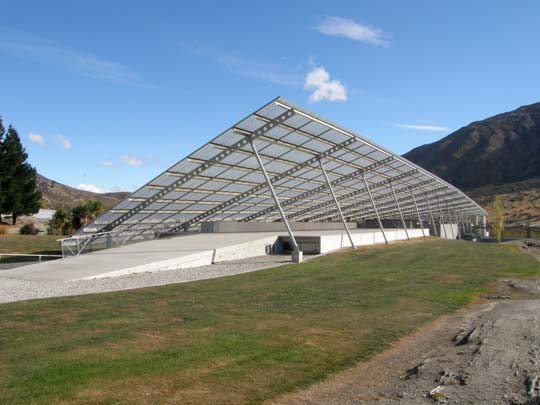
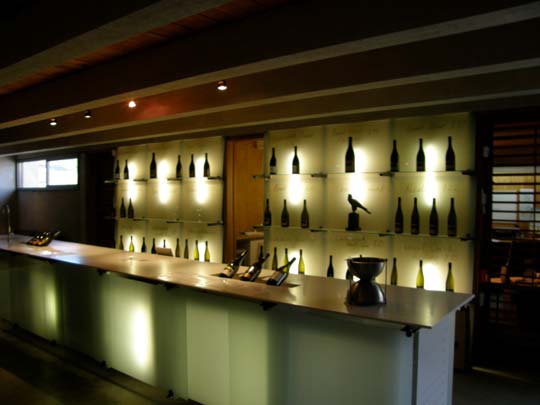 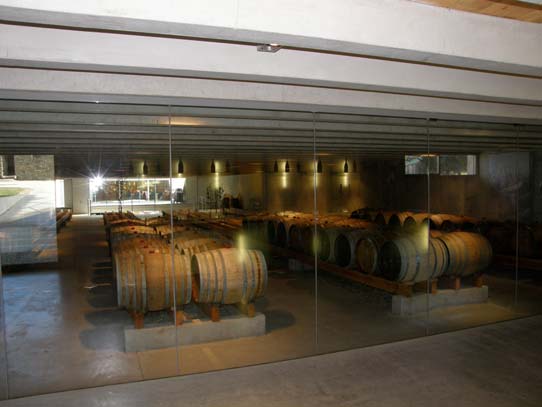
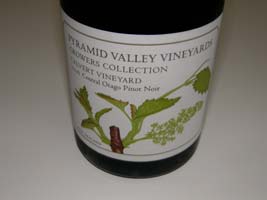 2006 Pyramid Valley Vineyards Growers Collection Calvert Vineyard Central Otago Pinot Noir 14.2% alc., $35, screw cap. Imported by Terra Firma Wine Co LLC, Oakland, CA. Owen and Michelle Calvert were married on and cultivate the Calvert Vineyard in the Bannockburn region of Central Otago. The vineyard is managed by the team at Felton Road who also bottle a vineyard-designate Pinot Noir from the vineyard. · An intensely fruity nose of dried black cherries, dark ripe berries, cranberry and rhubarb is echoed in the flavors which make an entry statement. Fruit-driven with a hint of earthiness, soft, dry tannins and grippy acidity on the tart finish. Will pick up complexity with time in the bottle.
Pyramid Valley Vineyards is a boutique winery owned by Mike and Claudia Weersing who buy grapes by the acre from vineyards in New Zealand. The Weersings have planted their own vineyards in limestone-rich soils near Pegasus Bay in Waipara. Winemaker Mike Weersing has an impressive winemaking resume, having worked in many top estates in Spain, Germany and France and brings meticulous and hands-on attention to the management of his vines. Because of extra canopy management, yields are typically 40-60% of that realized by other buyers of the same vineyard (0.7 tons per acre in 2007) with significantly better maturity. Winemaking features a strict minimum of additions - little or no sulfur, natural settling, no enzymes, fermentation exclusively with natural yeasts, natural malos, no finings, and filtration only when necessary. Production is tiny. The obvious commitment here suggests this label is poised for future stardom. The website is www.pyramidvalley.co.nz.
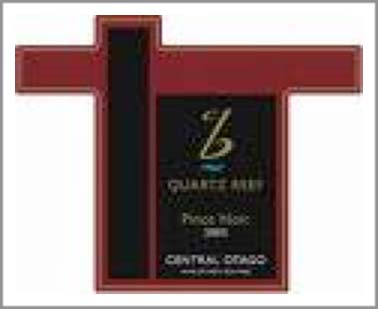 2006 Quartz Reef Central Otago Pinot Noir 14.5% alc., $29. Imported by Vine St Imports, Philadelphia, PA. Fruit is primarily from Bendigo Estate. Clonal mix is 10/5, 5, 115, 667, 777 and Abel. Aged in 37% new French oak. Egg white fined. · Generous scent of Bing cherries and new-mown hay. Driven by medium-weighted strawberry and cherry flavors enhanced by savory herbs. Nicely balanced, elegant and eminently satisfying.
Quartz Reef is located in Cromwell, Central Otago and farms 37 acres of vineyards at Bendigo Station. The largest quartz reef deposit in New Zealand lies beneath the vines of Quartz Reef Bendigo Estate Vineyard. The winemakers are Austrian born Rudi Bauer whose resume including stints at Misson, Rippon and Giesen, and Clotilde Chauvet, who made the first bottle-fermented sparkling wine in Central Otago at Rippon Vineyard, where she succeeded Rudi as winemaker. The winery makes a Central Otago blend of two vineyards and a more expensive Bendigo Estate Vineyard Pinot Noir which I have not seen in the States. The website is www.quartzreef.co.nz.
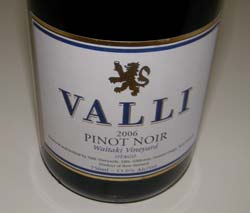 2006 Valli Waitaki Vineyard Central Otago Pinot Noir 13.0% alc., $40, screw cap. · The nose is a contrasting trio of fruity red cherries, floral notes, and stinky barnyard. Woody and vegetal flavors overwhelm the dark cherry fruit. Nicely weighted and silky in texture. Unusual flavor profile with some savory contributions I can’t put a finger on.
Valli Vineyards is a project begun in 1998 by Grant Taylor who previously garnered attention for his work at Gibbston Valley Winery, one of Central Otago’s first Pinot Noir producers. Taylor is attempting to highlight the sub-regional differences that exist in Central Otago from three vineyards including the estate Gibbston Vineyard, Bannockburn Vineyard and the Waitaki Vineyard. In 1995 he helped establish Oregon’s Archery Summit and has consulted there on a number of vintages since. The website is www.valliwine.com.
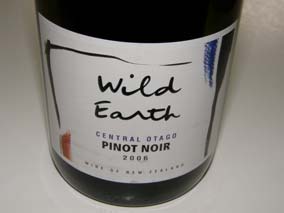 2006 Wild Earth Central Otago Pinot Noir 14.0% alc., $25, screw cap. Imported by San Francisco Exchange, San Francisco, CA. From vineyards on Felton Road and adjacent to Lake Dunstan. Crafted from 5, 6 and a range of Dijon clones. · A ripe, juicy, vivid and rich wine of great charisma. Great scent and flavors of fresh and sweet red and blue fruits. Supple tannins give it a caressing texture. A pretty Pinot that will charm the socks off you.
Wild Earth was established in 1998 and is a family owned business run by Quintin and Avril Quider. The 2006 Wild Earth PInot Noir (the third vintage of this wine) was awarded the coveted Top Red Wine trophy at the International Wine Challenge in London in September, surpassing thirty-one other red wine trophy winners from around the globe in the final judging round. Over 9,000 wines were submitted for judging making this the largest wine competition in the world. In addition to Top Red Wine, the wine won the award for Top International Pinot Noir, Top New Zealand Red Wine and Top International Red Wine. In May, the wine was awarded the Top New Zealand Pinot Noir trophy at the Decanter World Wine Awards. You might find the 2006 Pinot Noir sold out, but the 2007 vintage was released in September, 2008. Wild Earth wines are all estate-grown. Wild Earth owns 87 acres in two Central Otago locations - at the end of Felton Road overlooking the Kawarau River (the Bannockburn Estate) and the north Lowburn district beneath the Pisa Range (the Lowburn Estate). Intensive crop management practices are employed. The plantings include a mix of Dijon and UCD clones. For the 2005 to 2005 vintages, Michelle Richardson was the consultant to the winemaking and cellar team. Starting with the 2008 vintage, Grant Taylor joined Wild Earth as a consultant. A second label is called Blind Trail. The website is www.wildearthwines.co.nz.
2006 Pegasus Bay Waipara Valley Pinot Noir 14.0% alc., $35, screw cap. · Charming perfume of spicy red fruits, cinnamon, and a touch of herb farm. Straightforward red cherry flavors, slightly raisined, with noticeable but fine tannins, and a slightly dry and tart finish. Decent but not exceptional.
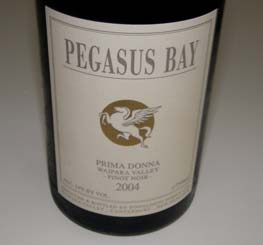 2004 Pegasus Bay Prima Donna Waipara Valley Pinot Noir 14.0% alc., $65, screw cap. Imported by Meadowbank Estates, Alexandria, VA. This wine is only made in small quantities from select barrels in special vintages. · Very sexy and rich scents of wild berries including olalliberries with complimentary dried herbs. Juicy and succulent black cherry and blackberry fruit with an appealing touch of earthiness, grilled meat and spicy oak. Not a bashful wine but light on its feet, with well-corralled tannins, and a clean and refreshing finish that goes on and on.
Pegasus Bay is a family owned and operated winery in Waipara, North Canterbury. The Pegasus was the name of the sailing ship which surveyed part of the South Island in 1809. The first mate of the brig Pegasus, William Stewart, gave Pegasus Bay its name. Waipara Valley is separated from the ocean (Pegasus Bay) by a range of hills which protect it from the cooling winds of the Pacific Ocean. To the West lie the Southern Alps (Main Divide) which shield Waipara from the hot northwest winds. The Donaldson family have been making wine since the early 1970s. Ivan Donaldson is a wine writer and wine judge and his two winemakers are his eldest son, Matthew, and Matthew’s spouse, Lynnette Hudson. Two other sons, Edward and Paul, also are involved in the business on the marketing and administration side. The winery operates a restaurant on the estate and a natural amphitheater hosts local and international acts. The website is www.pegasusbay.com.
Well, that’s it folks. My primary conclusion at the end of my travel to New Zealand and my extensive tasting is that many of the wines are more akin to the New World (both California and Oregon), while a lesser number of examples are more similar to the wines of Burgundy. In truth, a truly individualistic and distinctive style has not emerged. As New Zealand attempts to distinguish itself on the world wine stage, it will need to avoid the trend toward uniformity, look to express its wines as truly unique and not succumb to the influence of the critics and press who often fancy a particular style. The New Zealand wine industry is still in its infancy but its potential for producing tasty and varietally correct Pinot Noir is evident and the evolution of Middle Earth Pinot Noir will be enthusiastically monitored by wine enthusiasts including myself.
Quotes on PinotJeff Carlson, sommelier at Rat’s Restaurant in Hamilton, New Jersey, summed up the “it” grape as follows. “I talk about the four major producing areas for Pinot Noir. On the one side of the spectrum is Burgundy, the home of Pinot Noir, yielding wines that are complex and earthier. On the other side is California, with riper flavors and bigger fruit. In the middle, you have New Zealand, which leans more toward California. And then you have Oregon, which leans more toward Burgundy.” Well said. Actor Sam Neill, owner of Two Paddocks in Central Otago waxed on Pinot Noir. “I think Pinot is one of the most useful wines. It’s good with fish or meat, or even sitting around getting pissed with - there’s nothing wrong with that either.”
Tohu WinesTohu Wines, Ltd. is the world’s first wine company owned by the Maori, the indigenous people of New Zealand who arrived in New Zealand over eight centuries ago. They are said to share an anthropological relationship with the Polynesians. Tohu (pronounced “Tor-who”) is managed by three Maori tribal groups (Wi Pere Trust, Wakatu Inc and Ngati Rarua Atiawa Iwi Trust), and is the only indigenously produced New Zealand wine being exported to the United States (Total Beverage Solution & Vino Importers, Mt. Pleasant, SC). The Tohu vineyards are located in Gisborne, Nelson and Marlborough. All the vineyards are certified by Sustainable Winegrowing in New Zealand. A full range of wines is produced including Sauvignon Blanc, Riesling, Chardonnay, Pinot Gris and Pinot Noir. There are two Pinot Noirs - a Marlborough appellation wine and Rore, a reserve. The Rore Marlborough Reserve Pinot Noir won a Gold Medal and Top of Class award at this year’s London International Wines and Spirits Competition. The winemaker is Simon Waghorn and consultant viticulturalist is Dr. David Jordan, both leaders in their respective fields. Production has increased from 3,000 cases in the first vintage of 1998 to 60,000 cases in 2007. It is predicted that by 2012, production will be 140,000 cases per year. Sales of Tohu wines have been fueled by the fascination global markets have with the indigenous Maori culture. The website is www.tohu.co.nz.
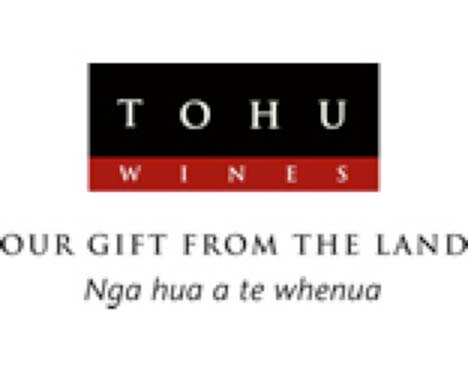 |
